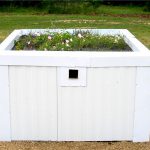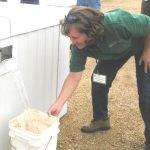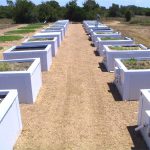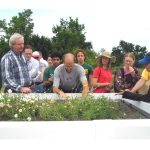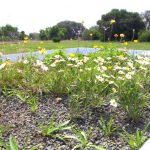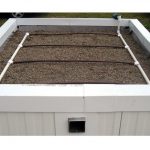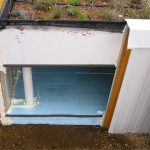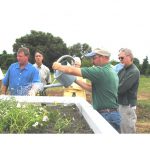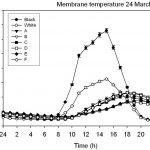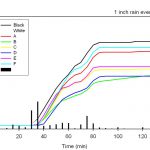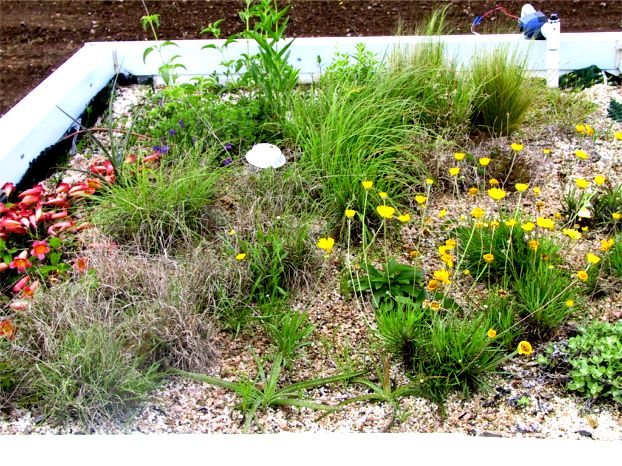
Additional Resources
Learn more about the Lady Bird Johnson Wildflower Center here, and the Native Green Roofs page here. See the Species List from Wildflower Center Research and more information on results.
The Lady Bird Johnson Wildflower Center at The University of Texas at Austin is dedicated to increasing the sustainable use and conservation of native plants and landscapes. Founded by former first lady, Lady Bird Johnson, in 1982, the Wildflower Center maintains an extensive native plant botanic garden and offers professional and adult education programming. The Wildflower Center also conducts research on landscape restoration and plant conservation at its 279-acre site, promoting the role of native plants and plant communities in addressing ecological problems. Recent research initiatives focus on native turf grasses, use of native plants on green roofs, and evaluation of carbon sequestration by native plants in urban landscapes.
With funding from Roof Consultants Institute Foundation, the City of Austin, and TBG partners, the Lady Bird Johnson Wildflower Center installed 21 test rooftops on a research plot adjacent to the Center’s Restoration Research Trail to see which plants do better in the often harsh local conditions, which growing media work best, and how surface temperatures vary with different types of roofs. The project is supported with labor and materials from local roofing contractors and a roofing industry group. Roofing consultant Brian Gardiner, with Austech Roof Consultants, helped initiate and design the Wildflower Center research project. Each test roof features a five-foot by six-foot green or conventional roof assembly that is three feet off the ground. The mini greenroofs contain 30 sq.ft. on 18 platforms for a total of 540 sq ft. Visitors will be able to view the green roof study from the Restoration Research Trail. During this three-to five-year research study the Wildflower Center will determine which native plants work best for green roof projects in Texas. While other green roof projects have used non-native plants, this is the first study of its kind to test native plants for green roofs in a sub-tropical environment like Austin.
The study also focuses on testing the key elements that could influence green roof design. Wildflower Center ecologists hope to determine a roof’s ability to retain water that sustains plant life without retaining excessive water that would make the roof system too heavy. The Wildflower Center wants to assess if we can take native drought tolerant plant species (both native Crassulaceaes as well as other plant families) and create an extensive green roof that has all the normal advantages of a green roof, but also maintains the regional character and natural heritage of the place where they exist. The research project will test the efficacy of native vegetation for use on extensive green roofs and clarify stormwater retention rates, water quality, and thermal properties of green roofing for subtropical regions. Common name plants currently being tested at the Wildflower Center include: Antelope Horns, Winecup, Damianita, Indian Blanket, Four-nerve Daisy, Barbara’s Buttons, Blackfoot Daisy, Pink evening primrose, Mealy Blue Sage, Shrubby scullcap, Red-flowered Yucca, Devil’s shoestring, Red flowered yucca, Spice lily, and Texas Sedum (visit website below for complete info, including scientific names).
The graphics below in the #10 and #11 positions show some of the data that the Wildflower Center has been collecting. It shows both the amount of water coming off the various roofs, as well as the membrane temperature for all the roofs. There is a traditional black top, a white top (?cool roof?), and green roofs from 6 different manufacturers (labeled A through F).
The first application of this study was the installation of approximately 8,000 square feet of green roof adjacent to a new Starbucks building at the corner of Loop 1 and Slaughter Lane in South Austin. The Wildflower Center contracted with Stratus Properties to design and install this green roof system in September 2005. See the Starbucks at Circle C Ranch project profile here.
 Greenroofs.comConnecting the Planet + Living Architecture
Greenroofs.comConnecting the Planet + Living Architecture
